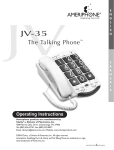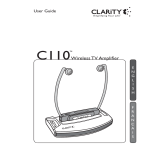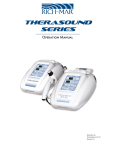Download Bacharach H-25C User manual
Transcript
H-10G Refrigerant Leak Detector User Manual Congratulations! You have just purchased the most versatile, high performance service leak detector available in the industry today. It will detect refrigerants with a sensitivity to effectively pinpoint both small and large leaks quickly and efficiently. We encourage your review of this manual to assure satisfactory performance and a long service life. Condensed Instructions 1. Plug power cord into an appropriate AC outlet and let unit warm up for 2 minutes. 2. Check flotation of airflow ball in probe tip. 3. Set Leak Size switch to SM (cal) position. 4. Adjust Balance Control until unit ticks slowly (1–3 ticks per second). 5. Place probe tip over Calibrate Reference Bottle (remove cap disc from bottle) and check for faster audio and flashing lamp. 6. Probe for leaks. 7. For other sensitivity ranges, set Leak Size switch and readjust Balance Control for 1–3 ticks per second. Model Description The H-10G Halogen Leak Detector consists of a control unit, a probe with 4-1/2 ft of hose, and an 8 ft power cord, all housed in a shock-resistant case. The control unit contains a printed circuit board amplifier, plug-in sensor, air pump, power transformer, and speaker housed beneath the chassis cover. A calibrate reference leak bottle, leak size switch, balance control, and power switch are located on the top of the control chassis. An AC power cord is attached on the inside left of the control chassis. A screwdriver adjustable sensor heat control is located on the bottom of the unit. The probe nozzle consists of a transparent tip, airflow ball, filter, and neon leak-signal lamp, connected to the control chassis by a length of flexible tubing. The calibrated reference leak is a removal bottle containing halogen gas R11, and is calibrated to provide a leak equivalent to approximately 0.5 ounce per year of R134a. As an accessory, a maintenance kit is provided that contains extra filters and airflow balls. Application The H-10G is intended principally for use as a serviceman’s tool, although it also can be used for production line leak testing. It was developed in response to an industry that is in the process of converting to more environmentally safe refrigerants worldwide. Ozone depleting chlorine is being reduced or eliminated in most refrigerants. To adequately leak test refrigerants like R123 and fluorine based R134a, higher detector sensitivity is required. The H-10G has the capability to detect small leaks for all current chlorine based refrigerants as well as the new fluorine based R134a or new blends under development. When using the H-10G you can be confident it has the sensitivity to meet your service needs of today and the capability of meeting your needs in the years to come. Please note that heavy gas contamination in the testing area may cause erratic operation of the H-10G. This can occur when the leak in the system is very large and there is little or no ventilation in the testing area. Contamination of an area may also occur where excessive amounts of refrigerants are vented. The H-10G cannot differentiate between atmospheric contamination and an actual leak because it will respond to any halogen gas passing over the heated sensor. However, a large leak often still can be located and the background contamination discriminated against by switching to the LG leak range. A contaminated condition can be improved greatly by ventilating or isolating the leak-check area. Important: Avoid placing the probe directly in a stream of concentrated halogen, as this will drastically shorten the sensor life. Operating Instructions 1. Before using the H-10G for the first time, remove the paper disc from the cap on the calibrate reference bottle (fig. 1) and allow a few minutes for the leak rate to stabilize. This disc is used to avoid evaporation and should be replaced after calibration. Be certain that the bottle contains a quantity of halogen R11. The liquid level can be observed by pulling the bottle up from its spring retainer clip and out of the panel. Initially this bottle is filled with enough halogen to last approximately 6 months. Fig. 1 2. Plug the power cord (fig. 1) into a 50/60 Hz AC outlet of the nominal voltage as listed on the unit’s rating plate. Caution: The H-10G is available for operation on either 110, 120, 220/230, or 240V AC. Operate the unit only on the proper supply voltage (as shown on the rating plate); otherwise the unit could be damaged. 3. The H-10G will start to warm up when the power cord is plugged into an AC outlet and the power switch is turned on. Allow 2 minutes for warm-up. Warning! Personal Injury Hazard Do not use the H-10G in an explosive or combustible atmosphere. The ambient atmosphere is drawn through the probe and through the sensor, which operates at approximately 1000°F (540°C). The resulting hot mixture of air and combustible gas could explode. 4. Check for sufficient airflow by pointing the probe tip toward the floor and observing the airflow ball in the probe. If the airflow is correct, the ball will rise and float above the tip of the probe (fig. 2). The height that the ball rises is not important as long as it rises. If the airflow ball does not rise, tap the probe lightly to make sure the ball is not sticking. If the ball does not rise at all due to insufficient airflow, check the filter in the probe tip, as described in the Maintenance section. If the flow is still insufficient, then the unit should be forwarded for repair to the nearest fig. 2 Authorized Service Center. 5. Place the leak size switch (fig. 1) in the SM (cal) position. 6. Adjust the balance control (fig. 1) until the audio ticks slowly, about 1–3 ticks per second. The neon lamp in the probe (fig. 2) will also flash, but much more slowly. 7. Place the probe tip over the hole in the cap of the calibrate reference bottle for 2–3 seconds. This allows enough time for the H-10G to pump down the concentration of gas which normally collects around the bottle’s outlet, and thus arrive at a steady state response (be sure that the bottle contains a quantity of refrigerant). The neon lamp in the probe should flash rapidly, and the audio pitch should increase markedly, but then back off somewhat from the saturated, full-scale howl. The calibrate reference bottle may be used as often as necessary to assure proper operation of determining the size of the leak. A leak that causes an audio pitch about equal to that produced by the calibrate reference has a leak rate of approximately the same size, 0.5 ounce per year of halogen R134a. Proper unit response during the R134a calibration reference test above verifies proper sensitivity and operation for all three test positions: small, medium, or large for either chlorine or fluorine based refrigerants. Please refer to the Product Sensitivity Levels chart on the pocket of the inside lid, or see this manual’s Specifications section. The term R12 sensitivity is used to represent chlorine based refrigerants such as R12, R22, R123, etc. Use the medium sensitivity switch position to locate 0.5 oz/yr or greater leaks of these type refrigerants. The term R134a ratings apply to the most difficult to detect, like fluorine based R134a or SF6. Use the small sensitivity switch position to locate 0.5 oz/yr or greater leaks of these type refrigerants. 8. Hold the probe as close as possible to the area being tested and move the tip at about one inch per second along seams or joints suspected of leaking. When the probe encounters a leak, both the audio pitch and the flashing rate of the neon lamp will increase. Both will continue to respond at the faster rate as long as the probe is held at the leak. 9. For detecting much larger or smaller leaks, set the leak size switch to the appropriate range LG or MED, readjust the balance control for slow ticking (1–3 ticks per second), and probe for leaks as in the previous step. The calibrate reference cannot be used to calibrate these two ranges. The factory, however, can supply leak standards of any value required for verification of capability to specific leak rates. Sensor Life Extension The H-10G provides a sensor adjustment that substantially extends sensor life. This procedure also provides for a more accurately calibrated sensitivity throughout the sensor life, and allows compensation for abnormally high or low line voltages (see Maintenance section). The sensor heat control is a screwdriver adjustment accessible through a hole on the bottom of the case. As the H-10G is used and the sensor ages, its sensitivity will gradually decrease. fig. 3 The overall sensitivity and calibration of the H-10G may be restored by gradually adjusting the sensor heat control clockwise until finally, with a fully aged sensor, the control knob will be turned clockwise to indicate 2 o’clock (fig. 3). After that, when the sensor fails to respond properly, replace the sensor following the procedure in the Maintenance section and readjust the sensor heat control back to 7 o’clock (fig. 3) and perform calibration. When making sensor adjustments, move the sensor heat control in small increments, either up or down, as appropriate. After each adjustment wait about 30 seconds for the sensor temperature to stabilize, then check the sensitivity as described in steps 5, 6, and 7, in the Operating Instructions section. Note: For best sensor life, avoid excessive sensitivity and excessive clockwise setting. Maintenance The H-10G is designed for long life with very little maintenance. A kit that contains the necessary expendable replacement parts is supplied with each unit. Instructions for replacing these items are described in the following sections. Replacing the Filter To protect the air pump from damage of foreign particles and moisture, replace the filter (fig. 2) often. With moderate use (15– 30 minutes per day), once a month should be sufficient. To replace the filter, pick out the old filter with a pin or tweezers. The fine screen will remain in the tip. Insert the new filter in the tip and make sure it is firmly seated against the fine screen. Replacing the Sensor The sensor is a plug-in unit that can be discarded when expended. It needs replacing when the H-10G no longer responds to the calibrate reference bottle, even with the sensor heat control fully clockwise. Make sure that the calibrate reference bottle contains fluid. 1. Unplug the AC power cord and open the sensor cover (fig.1). The sensor is now visible. 2. Allow the sensor to cool before touching it (approximately 15 minutes). 3. Unplug and discard the sensor. 4. Insert a new sensor and close the cover. 5. Set the sensor heat control (fig. 3) to its 7 o’clock position. 6. Place the unit in operation and check its sensitivity by following the procedure in steps 5, 6, and 7 in the Operating Instructions section. Gradually adjust the sensor heat control more clockwise until the proper response is obtained. Each time the sensor heat control is adjusted, make only small adjustments either up or down as appropriate. After each adjustment: wait about 30 seconds for the sensor temperature to stabilize; adjust balance knob to 1–3 ticks; and then re-check the sensitivity. WARNING! Personal Injury Hazard Sensor surface temperature may reach 390°F (200°C) during operation, and may cause a burn if not allowed to cool. Troubleshooting **Solution number corresponds to Cause number** Problem Responds continuously on small leak size positions. Balance control will not stop response. Cause 1 Excessive sensitivity 2 Atmosphere contaminated with excessive halogen Solution 1 Reset sensor heat control more counterclockwise. 2 Ventilate area, switch to larger leak size. Problem Excessive response to calibrate Reference Cause High line voltage Solution Reset sensor heat control more counterclockwise Problem Audio normal, but probe lamp does not flash Cause Burned out or damages probe lamp Solution Replace probe Problem Responds continuously on all leak size positions. Balance control will not stop response. Cause 1 Dirt in sensor 2 Short circuit in sensor Solution 1 Remove sensor and blow out with clean air (5 psi) to remove dirt. If unsuccessful, replace sensor. 2 Replace sensor Specifications Product Sensitivity (moving probe) (Movement not to exceed 2 in/sec, not greater than 0.25 inches from leak.) Switch Position R134a R12 LG 5.0 3.0 MD 1.0 0.5 SM 0.5 0.1 Product Sensitivity (stationary probe) (Probe directly on leak source, no movement.) Switch Position R134a R12 LG 5.0 3.0 MD 0.5 0.1 SM 0.1 .05 Power Supply ±10% (100, 120, 220, 240 volts) 50/60 Hz 20 watts, in accordance with rating plate. Response Time Approx. 1 second Reference Leak Approx. 0.5 oz/yr R134a. Approx. 6 months life, refillable with R11. Warm-up Time Approx. 2 minutes Temperature Operating 0°C to 45°C (32°F to 113°F) Storage 60°C (140°F) max. Dimensions 8.7 x 5.5 x 1.4 inches (22 x 14 x 7.5 cm) Weight 3.2 pounds (1.4kg) Repair Information Should it become necessary to repair your H-10G, please contact Central States Consulting, Inc. Units should be carefully packed to prevent shipping damage and shipped prepaid. Warranty Send units under warranty and a copy of the purchase receipt to Central States Consulting, Inc. for repairs. Please include your company name, telephone number including area code, and a contact name. Non-Warranty Units that are no longer under warranty will be repaired to factory specifications for a nominal fee. Please include your company name, telephone number including area code, and a contact name. Limited Warranty The purchaser is warranted that this leak detector will be free of defects in material and workmanship for 5 years from date of purchase. This warranty does not cover sensors, reference leaks, filters, airflow balls, lamps, or probe tips. Damages caused by the user will not be covered. If any defects are discovered during the warranty period, Central States Consulting, Inc. will repair or replace the unit at their option. The foregoing limited warranty is exclusive and in lieu of all other warranties, whether written or implied, and no warranty of merchantability or fitness for purpose will apply. Central States Consulting, Inc. Your Partner In Quality 8461 Standifer Gap Road Chattanooga, TN 37421 (800) 272-7022/(423) 305-0906 www.centralstatesconsulting.com [email protected]









